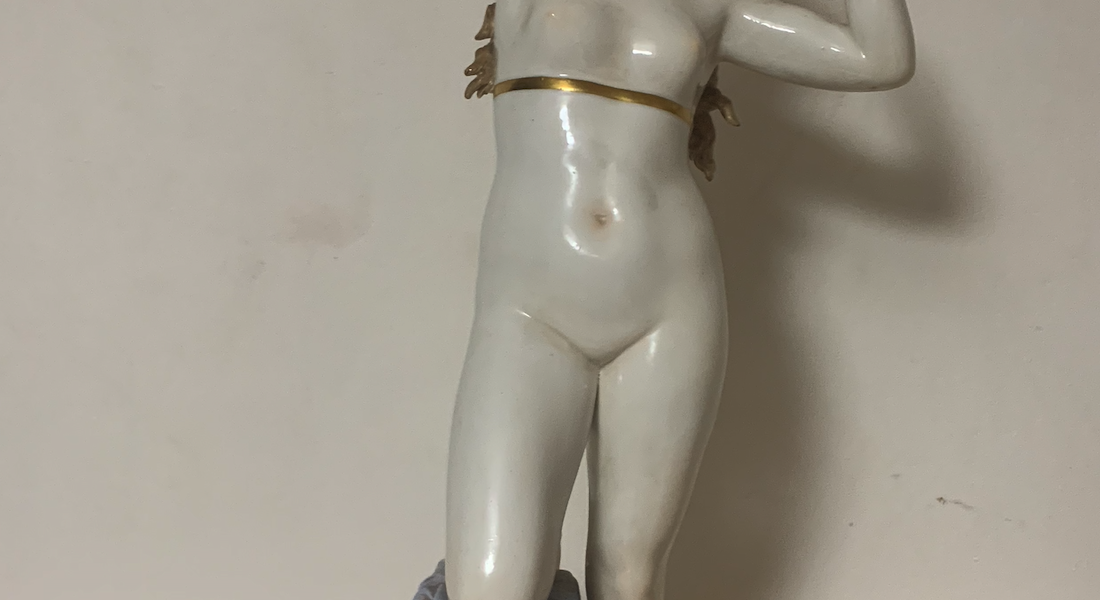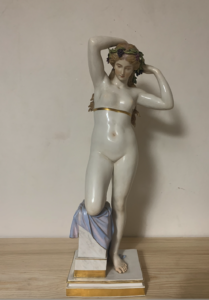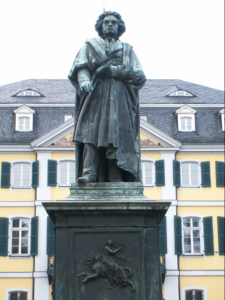
From time to time the Meissen Man will offer items for sale. This may include the rare, the important and just simply items that interest him.
The following is The Meissen Man’s most recent purchase:
A very rare and important late 19th century Meissen figure of a Nude modelled by the Master Modeller Ernst Julius Hähnel; Model no L155 circa 1880. Height 43cm. See information below about this item

This outstanding Mythological Nude Bacchante displays an enchanted facial expression. But there is a reason she worshiped the Roman God Bachus; while in Greece the Goddess Dionysus both bearers of Wine; Ectasy and Fertility. Seen in the form at Meissen modelled completely in the nude. Condition very good apart from small restoration to large toe of kneeling foot and small firing crack in For price and further photos please email [email protected]. Further images can be also seen on Instagram @themeissenman
‘Nude figures appeared in Mythology in the classic theme at Meissen since they were first produced in the middle of the 18th century. Kaendler was the chief modeller from the early 18th century and experimented with creating models of the Nude amongst more than 2000 models and designs. But his differed in that the majority, their private parts of the models were draped to hide their dignity.
Around 100 years later the Meissen management were facing stiff competition from France and England. It was during this time they employed the Swiss Artist Ernst August Leuteritz (1818) who became head of the painting department. Leuteritz recreated many of Kaendler’s models. but adding his own features that made them unique when compared to the 18th century originals. Models produced by Leuteritz or under his watchful eye are noted for their life-like facial expression. Particularly body features stand out prominently. Leuteritz standing for quality unsurpassed and stand out when compared to the majority of earlier of later modelling at Meissen.
The fashion during the 2nd half of the 19th century for Meissen was growing at a rate where the demand at times outshone the production. As well, with the Industrial Revolution in full swing there was stiff competition from other factories at home as well as abroad. Hundreds of smaller factories sprung up in the vicinity of Dresden (some of them imitating the cross swords trade-mark)as well as the more important Factory in Berlin that began to produce outstanding workmanship. Other than Berlin these factories wares cost a lot less than Meissen. There was also stiff competition from other countries in Europe. Especially Vienna in Austria and particularly at Sevres in France. Overseas in England the factories of Derby, Minton, Spode and Wedgwood added to an ever increasing demand that proved a formidable competition for the Meissen Management.
Hence although the management at Meissen were aware of Leuteritz’s perfectionism they were always looking for alternative avenues to increase their revenues.
Ernst Julius Hähnel (1811-1891) was amongst the most prolific sculptors in Germany during the 19th century as well as Professor at the Dresden Academy of Fine Arts. He is noted for his important sculpture of Beethoven in 1845 that stands in Bonn. See illustration below.


